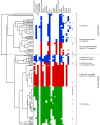Characterization of Streptococcus milleri group isolates from expectorated sputum of adult patients with cystic fibrosis
- PMID: 20007382
- PMCID: PMC2815602
- DOI: 10.1128/JCM.01807-09
Characterization of Streptococcus milleri group isolates from expectorated sputum of adult patients with cystic fibrosis
Abstract
With the recent insights into the Streptococcus milleri group (SMG) as pulmonary pathogens in patients with cystic fibrosis (CF), we sought to characterize 128 isolates from the sputum of adults with CF, along with 45 isolates from patients with invasive diseases for comparison. The tests performed included Lancefield grouping; tests for hemolysis; tests for the production of hyaluronidase, chondroitin sulfatase, DNase, proteases, and hydrogen peroxide; and PCR for the detection of the intermedilysin gene (ily). We also generated biochemical profiles with the Rapid ID Strep 32 API system and tested cell-free supernatants for the presence of the signal molecule autoinducer-2 (AI-2) using a Vibrio harveyi bioassay with a subset of CF strains. The S. intermedius isolates from both strain collections were similar, while the S. constellatus and S. anginosus isolates yielded several biotypes that differed in prevalence between the two strain collections. Beta-hemolytic, Lancefield group C S. constellatus comprised 74.4% of the S. constellatus isolates from patients with CF but only 13.3% of the corresponding isolates from patients with invasive infections. This was the only S. constellatus biotype associated with pulmonary exacerbations. Hyaluronidase-positive S. anginosus was detected only among the isolates from patients with CF. Strain-to-strain variability in AI-2 expression was evident, with the mean values being the highest for S. anginosus, followed by S. constellatus and then S. intermedius. Cluster analysis and 16S rRNA sequencing revealed that the species of SMG could be accurately determined with a minimum of three phenotypic tests: tests for the Lancefield group, hyaluronidase production, and chondroitin sulfatase production. Furthermore, isolates from patients with invasive infections clustered with isolates from the sputum of patients with CF, suggesting that the respiratory tract isolates were equally pathogenic.
Figures



Similar articles
-
Development of real-time PCR assays for detection of the Streptococcus milleri group from cystic fibrosis clinical specimens by targeting the cpn60 and 16S rRNA genes.J Clin Microbiol. 2010 Apr;48(4):1150-60. doi: 10.1128/JCM.02082-09. Epub 2010 Feb 17. J Clin Microbiol. 2010. PMID: 20164275 Free PMC article.
-
Genotypic and phenotypic characterization of "Streptococcus milleri" group isolates from a Veterans Administration hospital population.J Clin Microbiol. 1999 Nov;37(11):3681-7. doi: 10.1128/JCM.37.11.3681-3687.1999. J Clin Microbiol. 1999. PMID: 10523574 Free PMC article.
-
Evaluation of genotypic and phenotypic methods for differentiation of the members of the Anginosus group streptococci.Eur J Clin Microbiol Infect Dis. 2009 Sep;28(9):1123-8. doi: 10.1007/s10096-009-0758-9. Epub 2009 Jun 4. Eur J Clin Microbiol Infect Dis. 2009. PMID: 19495818 Free PMC article.
-
The Streptococcus milleri group--an unrecognized cause of disease in cystic fibrosis: a case series and literature review.Pediatr Pulmonol. 2008 May;43(5):490-7. doi: 10.1002/ppul.20809. Pediatr Pulmonol. 2008. PMID: 18383109 Review.
-
Molecular pathogenicity of Streptococcus anginosus.Mol Oral Microbiol. 2014 Aug;29(4):145-55. doi: 10.1111/omi.12056. Epub 2014 Jun 26. Mol Oral Microbiol. 2014. PMID: 24848553 Review.
Cited by
-
The emerging relationship between the airway microbiota and chronic respiratory disease: clinical implications.Expert Rev Respir Med. 2011 Dec;5(6):809-21. doi: 10.1586/ers.11.76. Expert Rev Respir Med. 2011. PMID: 22082166 Free PMC article. Review.
-
The development and application of a molecular community profiling strategy to identify polymicrobial bacterial DNA in the whole blood of septic patients.BMC Microbiol. 2015 Oct 16;15:215. doi: 10.1186/s12866-015-0557-7. BMC Microbiol. 2015. PMID: 26474751 Free PMC article.
-
Virulence factors of Streptococcus anginosus - a molecular perspective.Front Microbiol. 2022 Oct 26;13:1025136. doi: 10.3389/fmicb.2022.1025136. eCollection 2022. Front Microbiol. 2022. PMID: 36386673 Free PMC article. Review.
-
Airway Mucins Inhibit Oxidative and Non-Oxidative Bacterial Killing by Human Neutrophils.Front Pharmacol. 2020 Sep 30;11:554353. doi: 10.3389/fphar.2020.554353. eCollection 2020. Front Pharmacol. 2020. PMID: 33101020 Free PMC article.
-
Phylogenetic relationship and virulence inference of Streptococcus Anginosus Group: curated annotation and whole-genome comparative analysis support distinct species designation.BMC Genomics. 2013 Dec 17;14:895. doi: 10.1186/1471-2164-14-895. BMC Genomics. 2013. PMID: 24341328 Free PMC article.
References
-
- Bassler, B. L., M. Wright, and M. R. Silverman. 1994. Multiple signalling systems controlling expression of luminescence in Vibrio harveyi: sequence and function of genes encoding a second sensory pathway. Mol. Microbiol. 13:273-286. - PubMed
-
- Belko, J., D. A. Goldmann, A. Macone, and A. K. M. Zaidi. 2002. Clinically significant infections with organisms of the Streptococcus milleri group. Pediatr. Infect. Dis. J. 21:715-723. - PubMed
-
- Bridge, P. D., and P. H. Sneath. 1983. Numerical taxonomy of Streptococcus. J. Gen. Microbiol. 129:565-597. - PubMed
-
- Duan, K., C. Dammel, J. Stein, H. Rabin, and M. G. Surette. 2003. Modulation of Pseudomonas aeruginosa gene expression by host microflora through interspecies communication. Mol. Microbiol. 50:1477-1491. - PubMed
Publication types
MeSH terms
Substances
Grants and funding
LinkOut - more resources
Full Text Sources
Medical
Molecular Biology Databases

